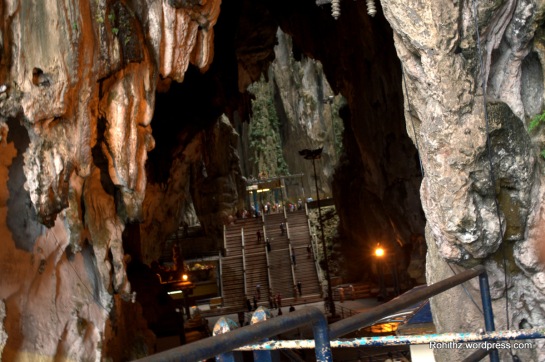Batu Caves is a limestone hill that has a series of caves and cave temples in the Gombak district, 13 Kms from Kuala Lumpur, Malaysia. It takes its name from Batu River, which flows past the hill. The cave is one of the most popular Hindu shrines outside India, and is dedicated to Lord Murugan. It is the focal point of Hindu festival of Thaipusam in Malaysia.
History:
This place has became famous only after the limestone hills were recorded by colonial authorities including Daly and Syers as well as American Naturalist, William Hornaday in 1878. Batu Caves was promoted as a place of worship by K. Thamboosamy Pillai, an Indian trader. He was inspired by the ‘vel’-shaped entrance of the main cave and was inspired to dedicate a temple to Lord Murugan within the caves.
In 1890, Pillai, who also founded the Sri Mahamariamman Temple, Kuala Lumpur, installed the murti (consecrated statue) of Sri Murugan Swami in what is today known as the Temple Cave. Since 1892, the Thaipusam festival in the Tamil month of Thai (which falls in late January/early February) has been celebrated there. Wooden steps up to the Temple Cave were built in 1920 and have since been replaced by 272 concrete steps.

‘Lord Murugan Statue’ is the tallest statue of Hindu deity in Malaysia and second tallest statue of Hindu deity in world, only second place to the Kailashnath Mahadev Statue in Nepal. It also the tallest statue in Malaysia at 42.7 metres (140 ft) in height.

A view from the top of the Batu caves. Rising almost 100 m above the ground, the Batu Caves temple complex consists of three main caves and a few smaller ones. The biggest, referred to as Cathedral Cave or Temple Cave, has a very high ceiling and features ornate Hindu shrines.
Tips from my perspective:
1. To reach it’s better to take Intrakota bus No 11D from the Central Market or the City liner bus No 69 at Jalan Pudu to get to Batu Caves. Taxis are also available anywhere around city.
2. Be careful while carrying food because the monkeys may snatch it out of your hands.
3. Trust me you won’t regret climbing up the stairs, though it looks a lot to climb. Once you reach the top you can learn a lot about Hinduism. Paintings and scenes of Hindu Gods can also be seen in the Ramayana Cave.
A great place to add to your itinerary when you visit Malaysia. 🙂 🙂



Nice!!
Beautiful pictures and a nice write up about the temple.
Thanks for that tip about monkeys snatching food. I have first hand experience with that one near a temple in Bhubaneswar, Orissa and I was scared to death. They snatched the peanuts I had neatly wrapped in a piece of newspaper. How I wish someone had shared that same tip with me back then. 🙂
Thank you so much dear!! Sad to know that you’ve a bad experience in Orissa. You should be more careful from next time onwards. Have a nice day!
Lovely Pictures of Lord Murugan and excellent travel tips. Thank you for sharing your journey. Kindest Regards Cheryle
Thank you so much Cheryle for taking time in reading my blog and leaving a positive comment. I’m glad to see you liking my posts. Take care and have a nice day dear!
Reblogged this on Ancien Hippie.
Thank you for Reblogging! 🙂